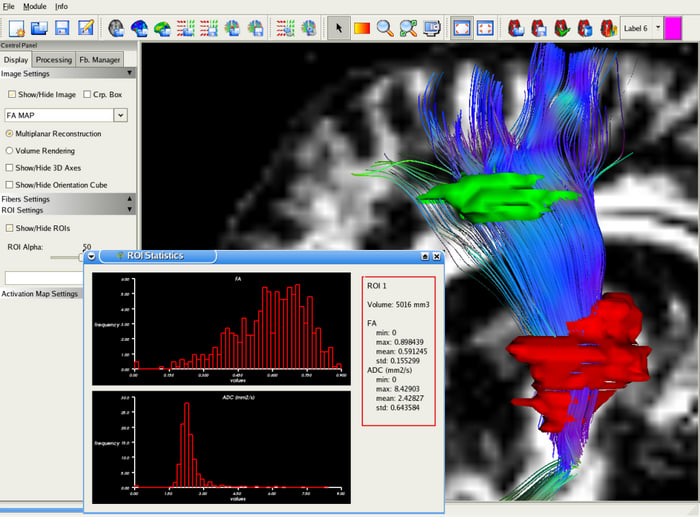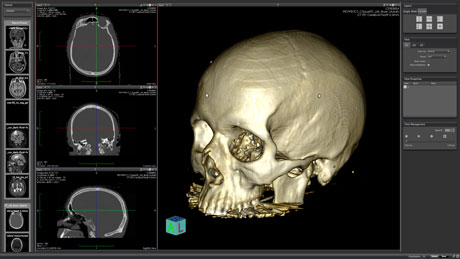
The standalone installation package has a small size and cross-platform support.ĭiffusionKit provides a complete pipeline with cutting-edge methods for dMRI data analysis, including both a GUI interface and command-line functions. Additionally, it provides both a graphical user interface (GUI) and command-line functions, which are helpful for batch processing.
MEDINRIA TRACTOGRAPHY DTI UPDATE
A mailing list has also been established for update notification and questions and answers.ĭiffusionKit provides a full-function pipeline for dMRI data analysis, including data processing, modeling and visualization.
MEDINRIA TRACTOGRAPHY DTI SERIES
The website of DiffusionKit includes test data, a complete tutorial and a series of tutorial examples. The DiffusionKit package is implemented in C/C++ and Qt/VTK, is freely available at and.
MEDINRIA TRACTOGRAPHY DTI INSTALL
Furthermore, DiffusionKit is a self-contained executable toolkit, without the need to install any other software. It delivers a complete pipeline, including data format conversion, dMRI preprocessing, local reconstruction, white matter fiber tracking, fiber statistical analyses and various visualization schemes. In this work, we developed a light, one-stop, cross-platform solution for dMRI data analysis, called DiffusionKit. However, the existing toolkits for dMRI analysis that have accompanied this surge possess noticeable limitations, such as large installation size, an incomplete pipeline, and a lack of cross-platform support. A sufficiently significant cor- relation of the generalized FA values was not found over the white matter tracts of the olfactory system.ĭiffusion magnetic resonance imaging (dMRI) techniques are receiving increasing attention due to their ability to characterize the arrangement map of white matter in vivo. Results: A significant negative correlation between ADC values and age was obtained. Gen- eralized diffusion parameters such as Fractional Anisotropy (FA) and Apparent Diffusion Coefficient (ADC) of the total tracts of white matter were correlated with age using a Pear- son correlation. The study was conducted with the consent of their parents. Materials and methods: Diffusion tensor imaging was per- formed in fifty-one volunteer children, aged 6-16 years.

The intrinsic trajectories of the olfactory pathway that can be identified using the dif- fusion-weighted magnetic resonance technique provide an important anatomical reference for the evaluation of clinical disorders commonly associated with the olfactory system in the brains of pediatric patients. Diffusion tensor imaging allows virtual dissections of functional white matter tracts in the human brain in vivo using regions of interest (ROI). Introduction: One of the techniques of Nuclear Magnetic Resonance is Diffusion Tensor Imaging, which measures the speed of diffusion of extracellular water molecules found in tissues. Objective: To characterize white matter tracts of the olfac- tory system and evaluate differences in diffusion parameters as a function of age in healthy children. The strategy is the foundation to study human neurodegenerative diseases and neurodevelopment as well. This manuscript presents a strategy to display neuronal trending representations that follow the corticospinal tract's pathway and neuronal integrity in small rodents. Although these water diffusion methods have proven to be successful in detecting neuronal structure at the submillimeter scale, they yield noisy results when applied to the resolutions required by small animals or when facing low myeline contents as in neonates and young children.

Neurons' integrity is now indirectly visible under specialized mechanisms that use water displacement to track static boundaries. Magnetic resonance, in particular, favors long-term analysis and monitoring since its methods do not perturb the organ functions nor compromise the metabolism of the animals. Thanks to recent technological advances in imaging, animals do not need to be sacrificed. More avidly than other human organs, we study the brain through animal models due to the complexity of experimenting directly on human subjects, even at a cellular level where the skull makes tissue sampling harder than in any other organ.

Testing on small animal models is roughly the only path to transfer science-based knowledge to human use.


 0 kommentar(er)
0 kommentar(er)
